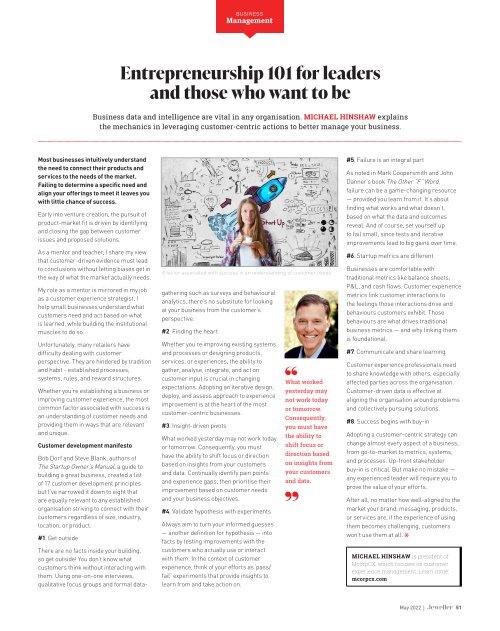Jeweller - May 2022
A new era: The pearl industry has been strengthened by adversity Responsibly sourced: Retailers want to provide it, but what does it really mean? Crystal ball: In order to predict trends, we learn from the past
A new era: The pearl industry has been strengthened by adversity
Responsibly sourced: Retailers want to provide it, but what does it really mean?
Crystal ball: In order to predict trends, we learn from the past
Create successful ePaper yourself
Turn your PDF publications into a flip-book with our unique Google optimized e-Paper software.
BUSINESS<br />
Management<br />
Entrepreneurship 101 for leaders<br />
and those who want to be<br />
Business data and intelligence are vital in any organisation. MICHAEL HINSHAW explains<br />
the mechanics in leveraging customer-centric actions to better manage your business.<br />
Most businesses intuitively understand<br />
the need to connect their products and<br />
services to the needs of the market.<br />
Failing to determine a specific need and<br />
align your offerings to meet it leaves you<br />
with little chance of success.<br />
Early into venture creation, the pursuit of<br />
product-market fit is driven by identifying<br />
and closing the gap between customer<br />
issues and proposed solutions.<br />
As a mentor and teacher, I share my view<br />
that customer-driven evidence must lead<br />
to conclusions without letting biases get in<br />
the way of what the market actually needs.<br />
My role as a mentor is mirrored in my job<br />
as a customer experience strategist. I<br />
help small businesses understand what<br />
customers need and act based on what<br />
is learned, while building the institutional<br />
muscles to do so.<br />
Unfortunately, many retailers have<br />
difficulty dealing with customer<br />
perspective. They are hindered by tradition<br />
and habit - established processes,<br />
systems, rules, and reward structures.<br />
Whether you’re establishing a business or<br />
improving customer experience, the most<br />
common factor associated with success is<br />
an understanding of customer needs and<br />
providing them in ways that are relevant<br />
and unique.<br />
Customer development manifesto<br />
Bob Dorf and Steve Blank, authors of<br />
The Startup Owner’s Manual, a guide to<br />
building a great business, created a list<br />
of 17 customer development principles<br />
but I’ve narrowed it down to eight that<br />
are equally relevant to any established<br />
organisation striving to connect with their<br />
customers regardless of size, industry,<br />
location, or product.<br />
#1. Get outside<br />
There are no facts inside your building,<br />
so get outside! You don’t know what<br />
customers think without interacting with<br />
them. Using one-on-one interviews,<br />
qualitative focus groups and formal data-<br />
A factor associated with success is an understanding of customer needs.<br />
gathering such as surveys and behavioural<br />
analytics, there’s no substitute for looking<br />
at your business from the customer’s<br />
perspective.<br />
#2. Finding the heart<br />
Whether you’re improving existing systems<br />
and processes or designing products,<br />
services, or experiences, the ability to<br />
gather, analyse, integrate, and act on<br />
customer input is crucial in changing<br />
expectations. Adopting an iterative design,<br />
deploy, and assess approach to experience<br />
improvement is at the heart of the most<br />
customer-centric businesses.<br />
#3. Insight-driven pivots<br />
What worked yesterday may not work today<br />
or tomorrow. Consequently, you must<br />
have the ability to shift focus or direction<br />
based on insights from your customers<br />
and data. Continually identify pain points<br />
and experience gaps, then prioritise their<br />
improvement based on customer needs<br />
and your business objectives.<br />
#4. Validate hypothesis with experiments<br />
Always aim to turn your informed guesses<br />
— another definition for hypothesis — into<br />
facts by testing improvements with the<br />
customers who actually use or interact<br />
with them. In the context of customer<br />
experience, think of your efforts as ‘pass/<br />
fail’ experiments that provide insights to<br />
learn from and take action on.<br />
What worked<br />
yesterday may<br />
not work today<br />
or tomorrow.<br />
Consequently,<br />
you must have<br />
the ability to<br />
shift focus or<br />
direction based<br />
on insights from<br />
your customers<br />
and data.<br />
#5. Failure is an integral part<br />
As noted in Mark Coopersmith and John<br />
Danner’s book The Other “F” Word,<br />
failure can be a game-changing resource<br />
— provided you learn from it. It’s about<br />
finding what works and what doesn’t,<br />
based on what the data and outcomes<br />
reveal. And of course, set yourself up<br />
to fail small, since tests and iterative<br />
improvements lead to big gains over time.<br />
#6. Startup metrics are different<br />
Businesses are comfortable with<br />
traditional metrics like balance sheets,<br />
P&L, and cash flows. Customer experience<br />
metrics link customer interactions to<br />
the feelings those interactions drive and<br />
behaviours customers exhibit. Those<br />
behaviours are what drives traditional<br />
business metrics — and why linking them<br />
is foundational.<br />
#7. Communicate and share learning<br />
Customer experience professionals need<br />
to share knowledge with others, especially<br />
affected parties across the organisation.<br />
Customer-driven data is effective at<br />
aligning the organisation around problems<br />
and collectively pursuing solutions.<br />
#8. Success begins with buy-in<br />
Adopting a customer-centric strategy can<br />
change almost every aspect of a business,<br />
from go-to-market to metrics, systems,<br />
and processes. Up-front stakeholder<br />
buy-in is critical. But make no mistake —<br />
any experienced leader will require you to<br />
prove the value of your efforts.<br />
After all, no matter how well-aligned to the<br />
market your brand, messaging, products,<br />
or services are, if the experience of using<br />
them becomes challenging, customers<br />
won’t use them at all.<br />
MICHAEL HINSHAW is president of<br />
McorpCX, which focuses on customer<br />
experience management. Learn more:<br />
mcorpcx.com<br />
<strong>May</strong> <strong>2022</strong> | 51


















